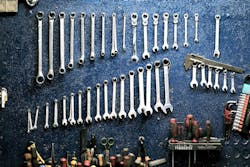Price-Match the Right Way
For Paul Berman, it’s a pet peeve rivaled only by Minnesota’s often inclement weather.
Berman, the fixed operations director at Burnsville (Minn.) Toyota, finds it frustrating when he hears consumers make the assumption that dealership maintenance costs more than that offered at oil-change chains.
It’s a perception Berman fights by clearly posting his service department pricing in his facility and on its website. He fights it another way, too: by utilizing price matching.
“It’s always been my philosophy to educate the customer as to our pricing,” Berman says. “If you don’t, customers will tend to think, ‘OK, once my car is out of warranty, I’m happy to go somewhere else, because dealerships are more expensive.’ …
“I believe the pricing here is reasonable, as it is at most dealerships—we have a reputation, and obviously we need to live that down.”
Berman, whose employer boasts a 65 percent customer retention rate and a 92.1 CSI score, gives his thoughts on how to price match effectively.
What we do is call our local Toyota dealerships that are competing dealerships, and ask them how they price their services—the oil changes, tire rotations, alignments, all that. Then we, or I, call aftermarket facilities around town, within a three-mile radius of us, and I ask them the same questions, and I compare them. Generally, I try to be in the middle of the pack with the Toyota dealerships and I try to be reasonable with the aftermarkets. In terms of margins, we’re striving for 50–55 percent labor gross profit, and 40 percent on parts.
When calling a Toyota dealership, I just say, “I’m a service manager; can I get some pricing from you?” Advisors are happy to talk. With the aftermarket facilities, I simply say, “Hey, my name is Paul, and I’m looking for pricing for a Toyota Camry 2016; what kind of price quotes can you give me for your service?” And they give me the prices, as if I’m a customer. If they called me and asked, I’d be happy to volunteer the information to them, so there’s nothing dishonest about that.
Put the information down on paper, using an Excel spreadsheet. Note different facilities on top, and then also put the name of the person you talked to and their contact info in that area, horizontally. Then, the vertical spreadsheet cells would be the oil change, the tire rotation, whatever it may be that you want shopped. Then, of course, put down the type of car that you want to price services for, like a 2016 Camry, because that needs to be asked on every phone call, to make sure that you’re comparing apples to apples. I eventually share the information from the spreadsheet with my coworkers, because it’s important for them to understand the market’s current pricing.
I believe you should put this information on your website. And, you should take the pricing information and make a billboard and have it in the service aisle, so the customers can see the oil change is $80. Either that, or have a TV monitor that flashes the prices. It’s one thing to have the information, but it’s another thing to do something with it. If you’re not doing that, you’re just wasting your time.
I wouldn’t be opposed to implementing a price-match guarantee, if needed. If I’ve got competing facilities that are charging $80 for an oil change, and I know mine has been at $69.95 for a couple years, and I continue to have people go to aftermarket facilities thinking that they’re cheaper, I might say, “I’ll tell you what, instead of me just trying to convince you, here’s my guarantee: Here’s my price, and if you can find that for something less expensive, I’ll match that.”
Twice per year, we put a mailer together for our clients, comparing the basic services between the facilities in our area. So, I’ll put our dealership, the benefits of coming here, the technicians and how many years of experience they’ve had, and so on. And then I put down, “not only do you get all of these benefits, but you’ll get pricing that’s competitive, or less.” Customers should see, “here’s the competitive pricing in our area—here’s us, and here are the other facilities near us. Compare them, and feel free to make up your own mind.” We do that at least twice per year, and then we also do the price-shopping calls three times per year, because most companies change prices often. It all takes effort, but if you don’t make the effort you’re not gonna make the gain.”
